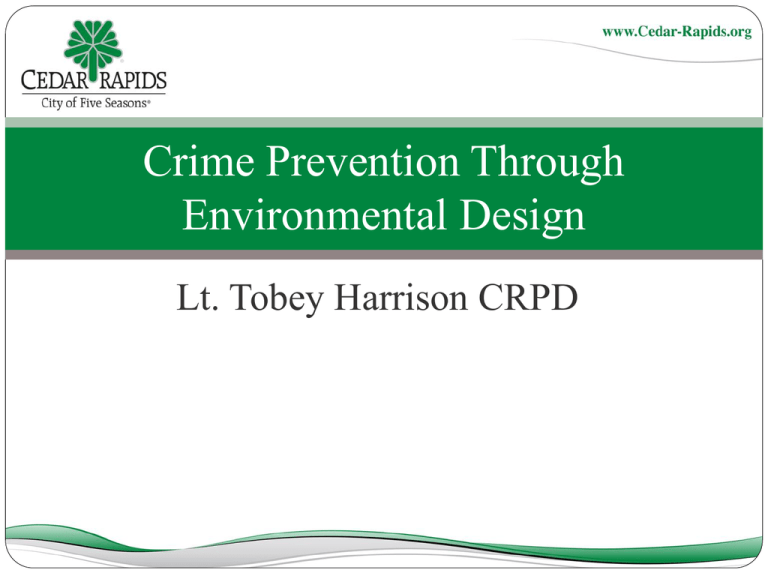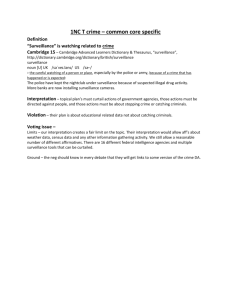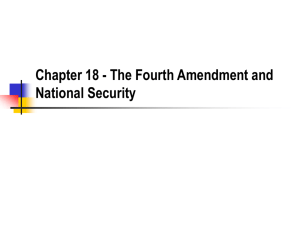Police - Crime Prevention
advertisement

Crime Prevention Through Environmental Design Lt. Tobey Harrison CRPD The term CPTED is used to describe a series of physical design characteristics that maximize resident control of criminal behavior within a residential community. A residential environment designed under CPTED guidelines clearly defines all areas as either public, semiprivate, or private. Territorial Reinforcement The purpose of C.P.T.E.D / Residential Security, is to give the property owner an opportunity to prevent or reduce crime. By making basic changes to the environment of their property, the property becomes more desirable to rent and less desirable to attract crime or the criminal element. Natural Surveillance Surveillance is a design concept directed primarily at keeping intruders under observation. The primary thrust of a surveillance strategy is to facilitate observation and to accomplish the effect of an increased perception of risk to would be criminals. Surveillance strategies are classified as organized (e.g., police patrol) mechanical (e.g., lighting) and natural (e.g., windows) Natural Access Control A design concept directed primarily at decreasing crime opportunity by denying access to crime targets and creating in offenders a perception of risk. Gained by designing streets, sidewalks, building entrances and neighborhood gateways to clearly indicate public routes and discouraging access to private areas with structural elements.. Target Hardening Accomplished by features that prohibit entry or access: window locks, dead bolts for doors, interior door hinges. Key Points Surveillance Access Control Territoriality Surveillance Natural Mechanical Organized Trees and Shrubs Obscuring Windows Poor location and trimming Trees Properly Trimmed Mechanical Surveillance Organized Surveillance Access Control • • • Limit Deny Control Movement Territoriality Pride of Property Sense of Ownership Psychological Barrier Residential Security 1. Outdoor Security 2. Indoor Security 3. Cost Effective Repairs vs. No Repairs 4. Security Survey Indoor Security 1. Doors: Quality of Door, Door Frame, Door Hinges, Storm and Screen Doors. 2. Locks: Types of locks, Lock Throw, Deadbolt, Key Control, Safe Vs. Non Safe Locks. 3. Windows: Glass Quality, Window Locks, Strengthening of windows. Deadbolts, Strike Plates and Screws Cost Effective Repairs 1. How Much Will This Cost? 2. Is It Worth It? 3. Why Do It? - Liability, Improving Quality of Life Issues at Rental Unit = Better Quality of Tenant & Better Property Value. 1. Cedar Rapids Burglary Trends 2. Tenant Loss Due to Lack of Security 3. Quality of Life Issues in a Neighborhood - I.E. Becoming an active partner in the neighborhood. 4. Partnership - Police, Landlord, Tenant, Neighborhood CPTED is the proper design and effective use of the built environment which may lead to a reduction in the fear and incidence of crime, and an improvement of the quality of life. Lt. Tobey Harrison CRPD Email t.harrison@cedar-rapids.org Ph. (319) 286-5542

